HA1022 Principles of Financial Management: BOQ Market Analysis
VerifiedAdded on 2023/04/04
|18
|3774
|374
Report
AI Summary
This report provides a comprehensive financial analysis of Bank of Queensland (BOQ) within the Australian financial market. It begins with an industry description, covering the size and competition level, key regulators like APRA, ASIC, and RBA, and industry groups such as the Australian Banking Association. The report details BOQ's business operations, organizational structure, and its role as a financial intermediary. A thorough analysis of financial instruments, including on and off-balance sheet items, is presented. Internal factors are assessed through key financial ratios like Net Interest Margin, Loan to Assets ratio, and Return on Average Equity, while external factors focus on competition from major banks and the impact of pricing and non-pricing strategies. The report also examines the interaction between financial players, government intervention, and past unethical practices. It concludes with recommendations for BOQ based on the analysis, emphasizing the importance of adapting to market competition and regulatory changes. Desklib provides access to this report and many other solved assignments for students.
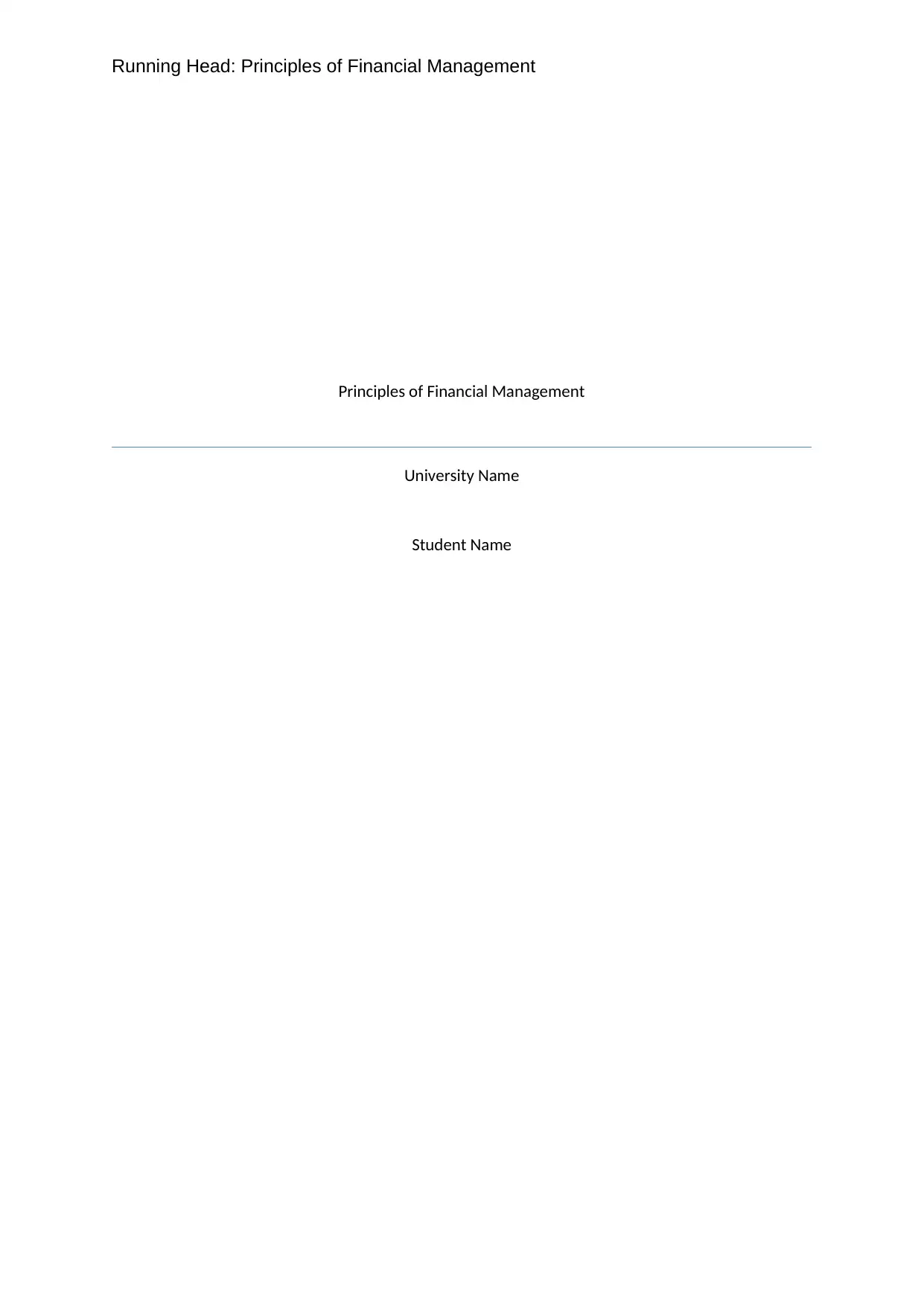
Running Head: Principles of Financial Management
Principles of Financial Management
University Name
Student Name
Principles of Financial Management
University Name
Student Name
Paraphrase This Document
Need a fresh take? Get an instant paraphrase of this document with our AI Paraphraser
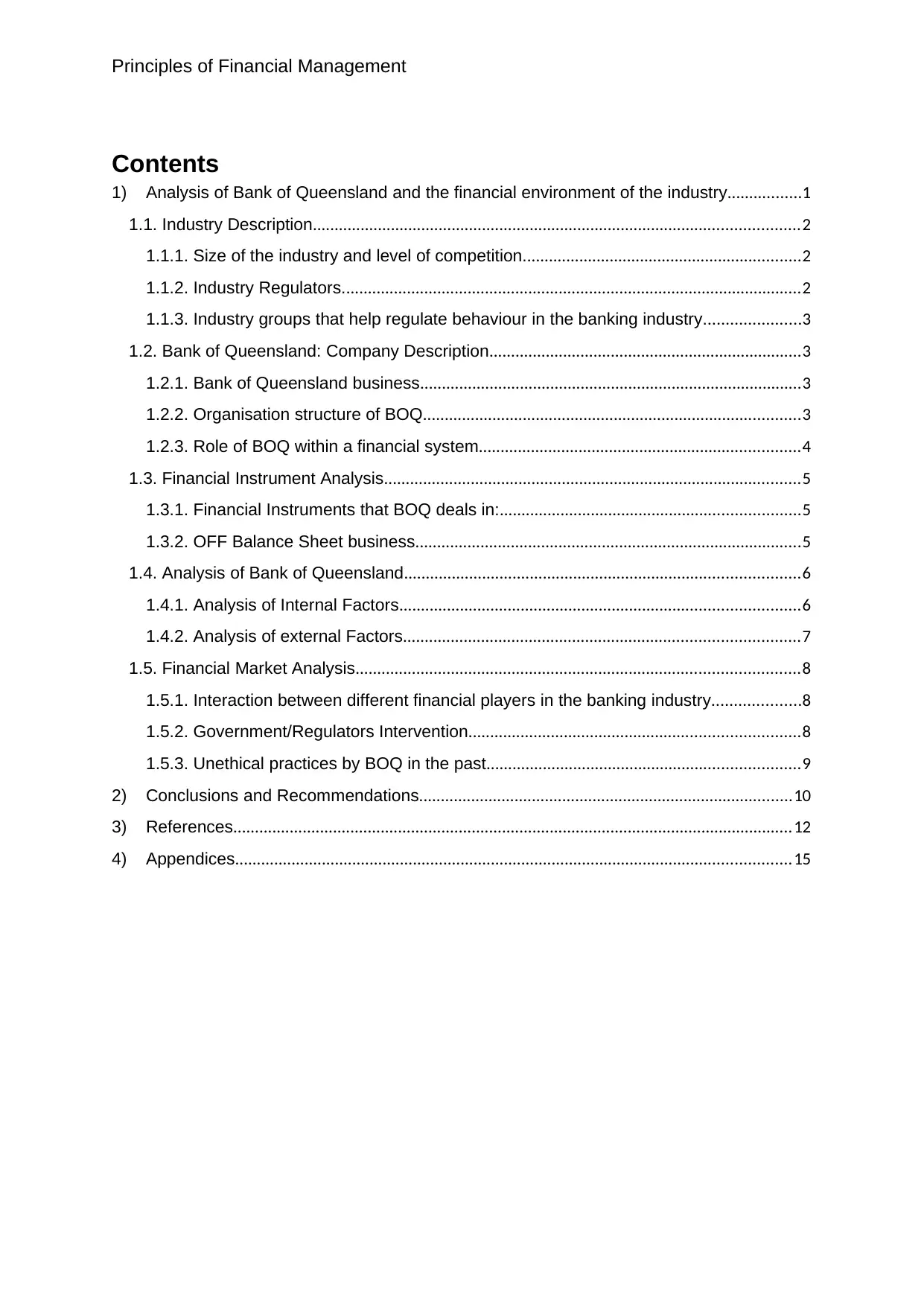
Principles of Financial Management
Contents
1) Analysis of Bank of Queensland and the financial environment of the industry.................1
1.1. Industry Description................................................................................................................2
1.1.1. Size of the industry and level of competition................................................................2
1.1.2. Industry Regulators..........................................................................................................2
1.1.3. Industry groups that help regulate behaviour in the banking industry......................3
1.2. Bank of Queensland: Company Description........................................................................3
1.2.1. Bank of Queensland business........................................................................................3
1.2.2. Organisation structure of BOQ.......................................................................................3
1.2.3. Role of BOQ within a financial system..........................................................................4
1.3. Financial Instrument Analysis................................................................................................5
1.3.1. Financial Instruments that BOQ deals in:.....................................................................5
1.3.2. OFF Balance Sheet business.........................................................................................5
1.4. Analysis of Bank of Queensland...........................................................................................6
1.4.1. Analysis of Internal Factors............................................................................................6
1.4.2. Analysis of external Factors...........................................................................................7
1.5. Financial Market Analysis......................................................................................................8
1.5.1. Interaction between different financial players in the banking industry....................8
1.5.2. Government/Regulators Intervention............................................................................8
1.5.3. Unethical practices by BOQ in the past........................................................................9
2) Conclusions and Recommendations......................................................................................10
3) References.................................................................................................................................12
4) Appendices................................................................................................................................15
Contents
1) Analysis of Bank of Queensland and the financial environment of the industry.................1
1.1. Industry Description................................................................................................................2
1.1.1. Size of the industry and level of competition................................................................2
1.1.2. Industry Regulators..........................................................................................................2
1.1.3. Industry groups that help regulate behaviour in the banking industry......................3
1.2. Bank of Queensland: Company Description........................................................................3
1.2.1. Bank of Queensland business........................................................................................3
1.2.2. Organisation structure of BOQ.......................................................................................3
1.2.3. Role of BOQ within a financial system..........................................................................4
1.3. Financial Instrument Analysis................................................................................................5
1.3.1. Financial Instruments that BOQ deals in:.....................................................................5
1.3.2. OFF Balance Sheet business.........................................................................................5
1.4. Analysis of Bank of Queensland...........................................................................................6
1.4.1. Analysis of Internal Factors............................................................................................6
1.4.2. Analysis of external Factors...........................................................................................7
1.5. Financial Market Analysis......................................................................................................8
1.5.1. Interaction between different financial players in the banking industry....................8
1.5.2. Government/Regulators Intervention............................................................................8
1.5.3. Unethical practices by BOQ in the past........................................................................9
2) Conclusions and Recommendations......................................................................................10
3) References.................................................................................................................................12
4) Appendices................................................................................................................................15
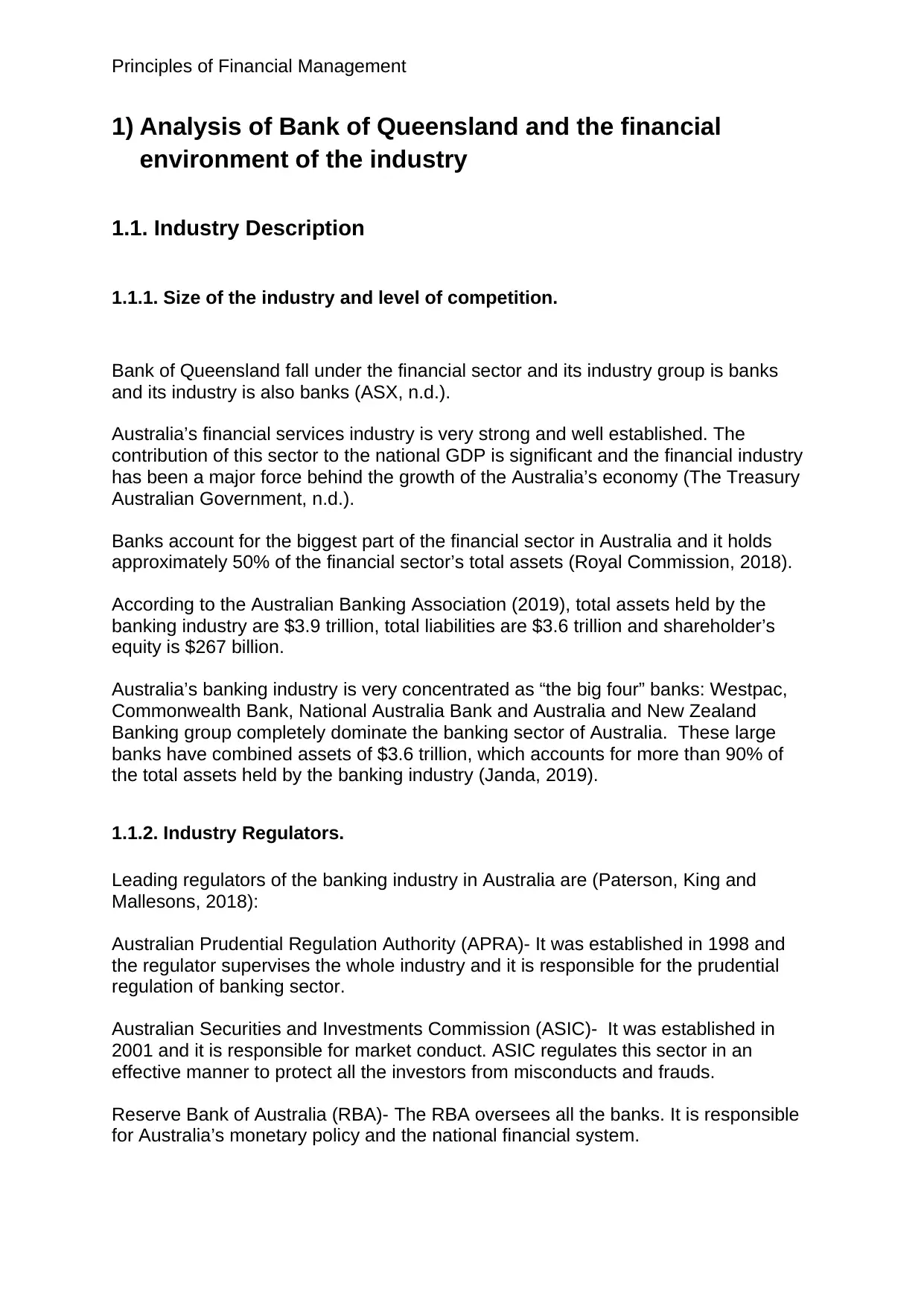
Principles of Financial Management
1) Analysis of Bank of Queensland and the financial
environment of the industry
1.1. Industry Description
1.1.1. Size of the industry and level of competition.
Bank of Queensland fall under the financial sector and its industry group is banks
and its industry is also banks (ASX, n.d.).
Australia’s financial services industry is very strong and well established. The
contribution of this sector to the national GDP is significant and the financial industry
has been a major force behind the growth of the Australia’s economy (The Treasury
Australian Government, n.d.).
Banks account for the biggest part of the financial sector in Australia and it holds
approximately 50% of the financial sector’s total assets (Royal Commission, 2018).
According to the Australian Banking Association (2019), total assets held by the
banking industry are $3.9 trillion, total liabilities are $3.6 trillion and shareholder’s
equity is $267 billion.
Australia’s banking industry is very concentrated as “the big four” banks: Westpac,
Commonwealth Bank, National Australia Bank and Australia and New Zealand
Banking group completely dominate the banking sector of Australia. These large
banks have combined assets of $3.6 trillion, which accounts for more than 90% of
the total assets held by the banking industry (Janda, 2019).
1.1.2. Industry Regulators.
Leading regulators of the banking industry in Australia are (Paterson, King and
Mallesons, 2018):
Australian Prudential Regulation Authority (APRA)- It was established in 1998 and
the regulator supervises the whole industry and it is responsible for the prudential
regulation of banking sector.
Australian Securities and Investments Commission (ASIC)- It was established in
2001 and it is responsible for market conduct. ASIC regulates this sector in an
effective manner to protect all the investors from misconducts and frauds.
Reserve Bank of Australia (RBA)- The RBA oversees all the banks. It is responsible
for Australia’s monetary policy and the national financial system.
1) Analysis of Bank of Queensland and the financial
environment of the industry
1.1. Industry Description
1.1.1. Size of the industry and level of competition.
Bank of Queensland fall under the financial sector and its industry group is banks
and its industry is also banks (ASX, n.d.).
Australia’s financial services industry is very strong and well established. The
contribution of this sector to the national GDP is significant and the financial industry
has been a major force behind the growth of the Australia’s economy (The Treasury
Australian Government, n.d.).
Banks account for the biggest part of the financial sector in Australia and it holds
approximately 50% of the financial sector’s total assets (Royal Commission, 2018).
According to the Australian Banking Association (2019), total assets held by the
banking industry are $3.9 trillion, total liabilities are $3.6 trillion and shareholder’s
equity is $267 billion.
Australia’s banking industry is very concentrated as “the big four” banks: Westpac,
Commonwealth Bank, National Australia Bank and Australia and New Zealand
Banking group completely dominate the banking sector of Australia. These large
banks have combined assets of $3.6 trillion, which accounts for more than 90% of
the total assets held by the banking industry (Janda, 2019).
1.1.2. Industry Regulators.
Leading regulators of the banking industry in Australia are (Paterson, King and
Mallesons, 2018):
Australian Prudential Regulation Authority (APRA)- It was established in 1998 and
the regulator supervises the whole industry and it is responsible for the prudential
regulation of banking sector.
Australian Securities and Investments Commission (ASIC)- It was established in
2001 and it is responsible for market conduct. ASIC regulates this sector in an
effective manner to protect all the investors from misconducts and frauds.
Reserve Bank of Australia (RBA)- The RBA oversees all the banks. It is responsible
for Australia’s monetary policy and the national financial system.
⊘ This is a preview!⊘
Do you want full access?
Subscribe today to unlock all pages.

Trusted by 1+ million students worldwide
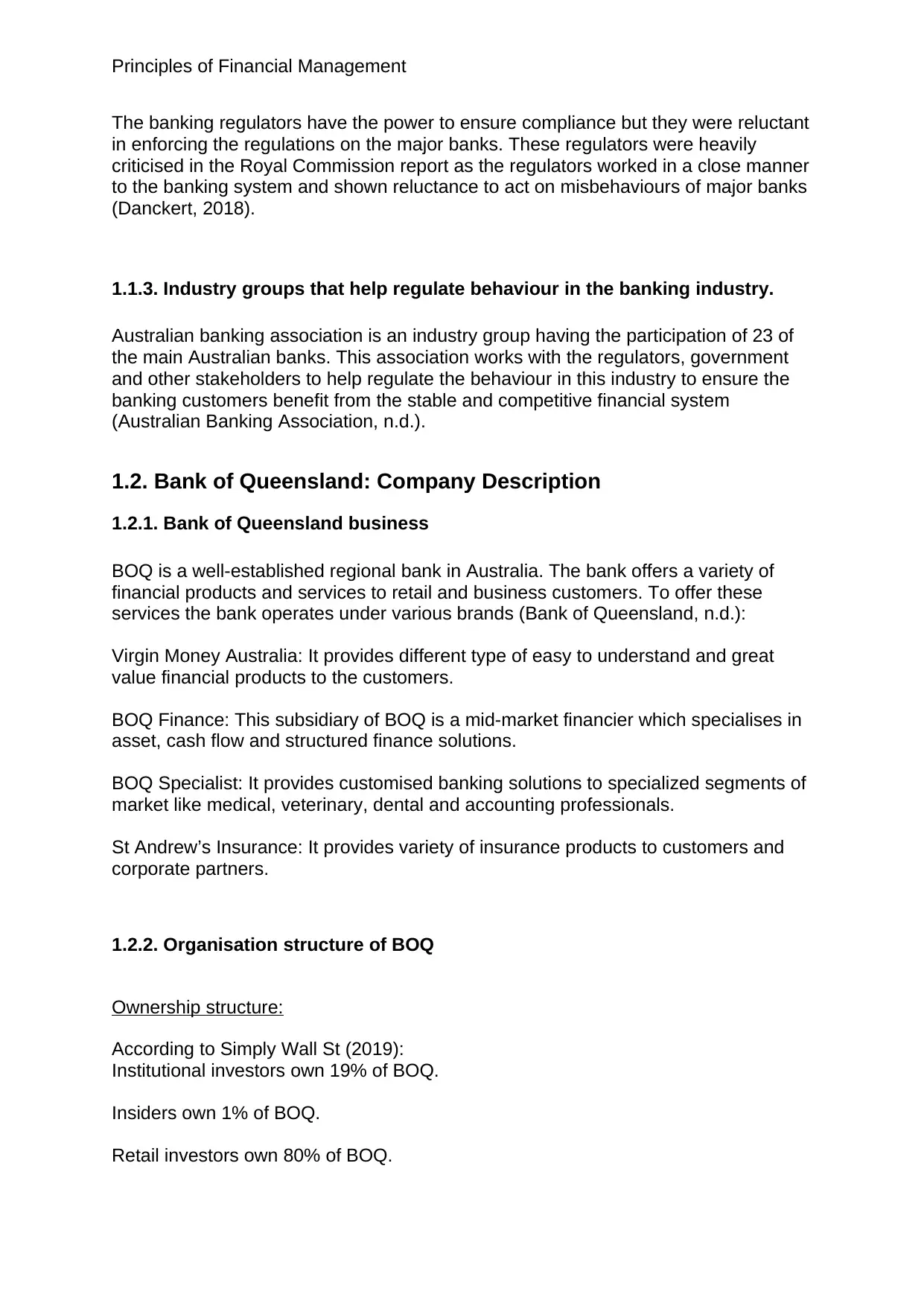
Principles of Financial Management
The banking regulators have the power to ensure compliance but they were reluctant
in enforcing the regulations on the major banks. These regulators were heavily
criticised in the Royal Commission report as the regulators worked in a close manner
to the banking system and shown reluctance to act on misbehaviours of major banks
(Danckert, 2018).
1.1.3. Industry groups that help regulate behaviour in the banking industry.
Australian banking association is an industry group having the participation of 23 of
the main Australian banks. This association works with the regulators, government
and other stakeholders to help regulate the behaviour in this industry to ensure the
banking customers benefit from the stable and competitive financial system
(Australian Banking Association, n.d.).
1.2. Bank of Queensland: Company Description
1.2.1. Bank of Queensland business
BOQ is a well-established regional bank in Australia. The bank offers a variety of
financial products and services to retail and business customers. To offer these
services the bank operates under various brands (Bank of Queensland, n.d.):
Virgin Money Australia: It provides different type of easy to understand and great
value financial products to the customers.
BOQ Finance: This subsidiary of BOQ is a mid-market financier which specialises in
asset, cash flow and structured finance solutions.
BOQ Specialist: It provides customised banking solutions to specialized segments of
market like medical, veterinary, dental and accounting professionals.
St Andrew’s Insurance: It provides variety of insurance products to customers and
corporate partners.
1.2.2. Organisation structure of BOQ
Ownership structure:
According to Simply Wall St (2019):
Institutional investors own 19% of BOQ.
Insiders own 1% of BOQ.
Retail investors own 80% of BOQ.
The banking regulators have the power to ensure compliance but they were reluctant
in enforcing the regulations on the major banks. These regulators were heavily
criticised in the Royal Commission report as the regulators worked in a close manner
to the banking system and shown reluctance to act on misbehaviours of major banks
(Danckert, 2018).
1.1.3. Industry groups that help regulate behaviour in the banking industry.
Australian banking association is an industry group having the participation of 23 of
the main Australian banks. This association works with the regulators, government
and other stakeholders to help regulate the behaviour in this industry to ensure the
banking customers benefit from the stable and competitive financial system
(Australian Banking Association, n.d.).
1.2. Bank of Queensland: Company Description
1.2.1. Bank of Queensland business
BOQ is a well-established regional bank in Australia. The bank offers a variety of
financial products and services to retail and business customers. To offer these
services the bank operates under various brands (Bank of Queensland, n.d.):
Virgin Money Australia: It provides different type of easy to understand and great
value financial products to the customers.
BOQ Finance: This subsidiary of BOQ is a mid-market financier which specialises in
asset, cash flow and structured finance solutions.
BOQ Specialist: It provides customised banking solutions to specialized segments of
market like medical, veterinary, dental and accounting professionals.
St Andrew’s Insurance: It provides variety of insurance products to customers and
corporate partners.
1.2.2. Organisation structure of BOQ
Ownership structure:
According to Simply Wall St (2019):
Institutional investors own 19% of BOQ.
Insiders own 1% of BOQ.
Retail investors own 80% of BOQ.
Paraphrase This Document
Need a fresh take? Get an instant paraphrase of this document with our AI Paraphraser
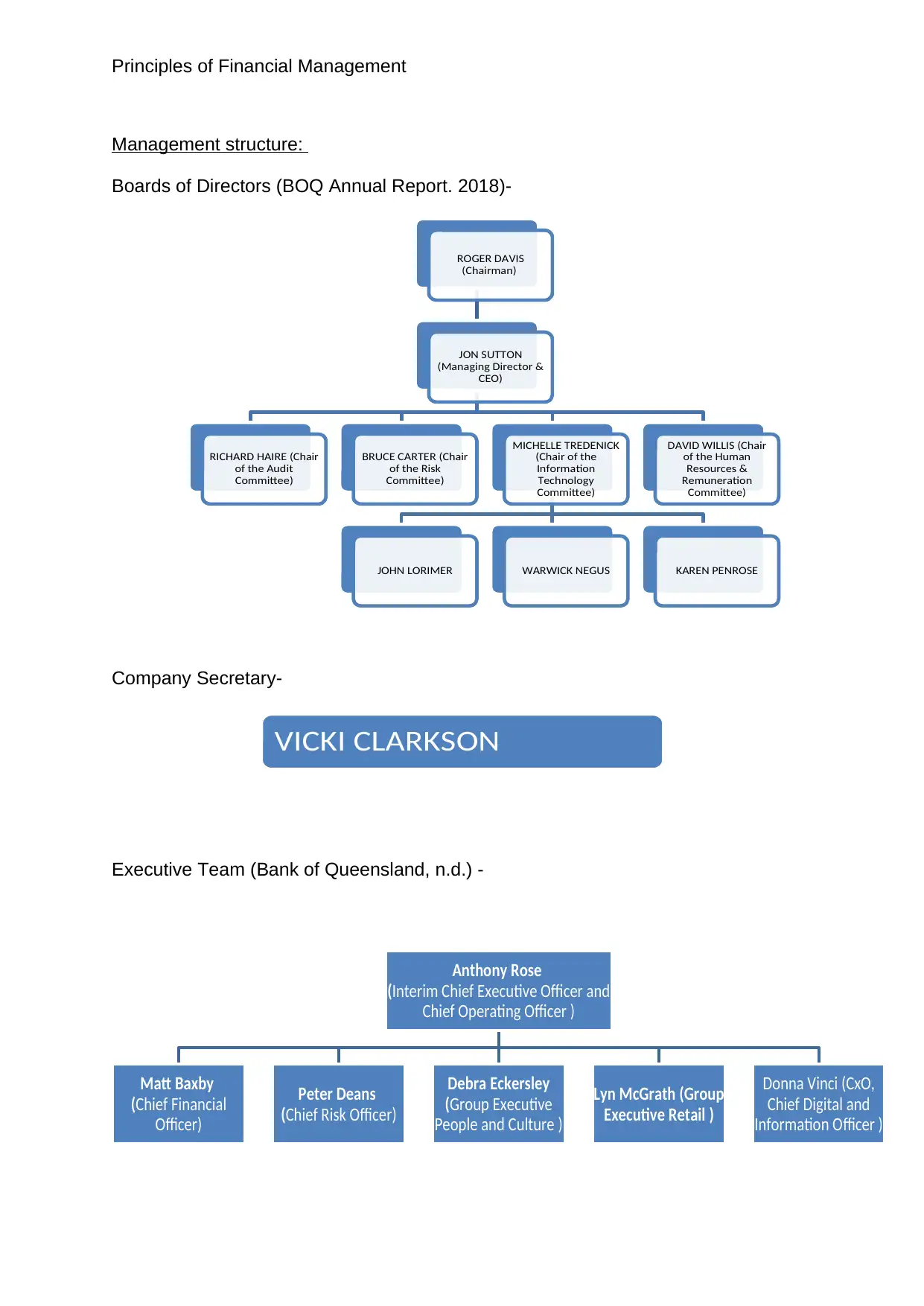
Principles of Financial Management
Management structure:
Boards of Directors (BOQ Annual Report. 2018)-
Company Secretary-
Executive Team (Bank of Queensland, n.d.) -
ROGER DAVIS
(Chairman)
JON SUTTON
(Managing Director &
CEO)
RICHARD HAIRE (Chair
of the Audit
Committee)
BRUCE CARTER (Chair
of the Risk
Committee)
MICHELLE TREDENICK
(Chair of the
Information
Technology
Committee)
JOHN LORIMER WARWICK NEGUS KAREN PENROSE
DAVID WILLIS (Chair
of the Human
Resources &
Remuneration
Committee)
VICKI CLARKSON
Anthony Rose
(Interim Chief Executive Officer and
Chief Operating Officer )
Matt Baxby
(Chief Financial
Officer)
Peter Deans
(Chief Risk Officer)
Debra Eckersley
(Group Executive
People and Culture )
Lyn McGrath (Group
Executive Retail )
Donna Vinci (CxO,
Chief Digital and
Information Officer )
Management structure:
Boards of Directors (BOQ Annual Report. 2018)-
Company Secretary-
Executive Team (Bank of Queensland, n.d.) -
ROGER DAVIS
(Chairman)
JON SUTTON
(Managing Director &
CEO)
RICHARD HAIRE (Chair
of the Audit
Committee)
BRUCE CARTER (Chair
of the Risk
Committee)
MICHELLE TREDENICK
(Chair of the
Information
Technology
Committee)
JOHN LORIMER WARWICK NEGUS KAREN PENROSE
DAVID WILLIS (Chair
of the Human
Resources &
Remuneration
Committee)
VICKI CLARKSON
Anthony Rose
(Interim Chief Executive Officer and
Chief Operating Officer )
Matt Baxby
(Chief Financial
Officer)
Peter Deans
(Chief Risk Officer)
Debra Eckersley
(Group Executive
People and Culture )
Lyn McGrath (Group
Executive Retail )
Donna Vinci (CxO,
Chief Digital and
Information Officer )
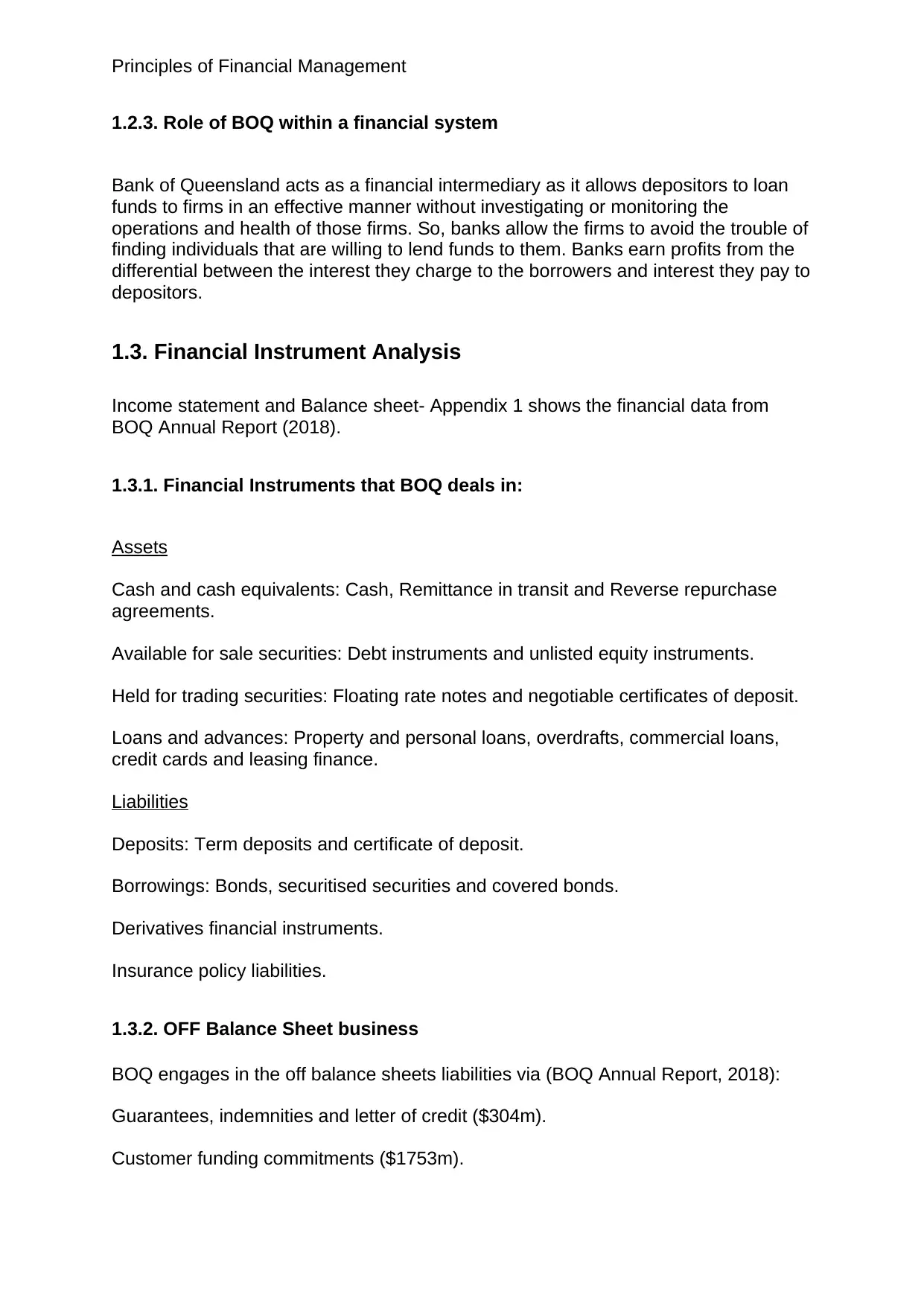
Principles of Financial Management
1.2.3. Role of BOQ within a financial system
Bank of Queensland acts as a financial intermediary as it allows depositors to loan
funds to firms in an effective manner without investigating or monitoring the
operations and health of those firms. So, banks allow the firms to avoid the trouble of
finding individuals that are willing to lend funds to them. Banks earn profits from the
differential between the interest they charge to the borrowers and interest they pay to
depositors.
1.3. Financial Instrument Analysis
Income statement and Balance sheet- Appendix 1 shows the financial data from
BOQ Annual Report (2018).
1.3.1. Financial Instruments that BOQ deals in:
Assets
Cash and cash equivalents: Cash, Remittance in transit and Reverse repurchase
agreements.
Available for sale securities: Debt instruments and unlisted equity instruments.
Held for trading securities: Floating rate notes and negotiable certificates of deposit.
Loans and advances: Property and personal loans, overdrafts, commercial loans,
credit cards and leasing finance.
Liabilities
Deposits: Term deposits and certificate of deposit.
Borrowings: Bonds, securitised securities and covered bonds.
Derivatives financial instruments.
Insurance policy liabilities.
1.3.2. OFF Balance Sheet business
BOQ engages in the off balance sheets liabilities via (BOQ Annual Report, 2018):
Guarantees, indemnities and letter of credit ($304m).
Customer funding commitments ($1753m).
1.2.3. Role of BOQ within a financial system
Bank of Queensland acts as a financial intermediary as it allows depositors to loan
funds to firms in an effective manner without investigating or monitoring the
operations and health of those firms. So, banks allow the firms to avoid the trouble of
finding individuals that are willing to lend funds to them. Banks earn profits from the
differential between the interest they charge to the borrowers and interest they pay to
depositors.
1.3. Financial Instrument Analysis
Income statement and Balance sheet- Appendix 1 shows the financial data from
BOQ Annual Report (2018).
1.3.1. Financial Instruments that BOQ deals in:
Assets
Cash and cash equivalents: Cash, Remittance in transit and Reverse repurchase
agreements.
Available for sale securities: Debt instruments and unlisted equity instruments.
Held for trading securities: Floating rate notes and negotiable certificates of deposit.
Loans and advances: Property and personal loans, overdrafts, commercial loans,
credit cards and leasing finance.
Liabilities
Deposits: Term deposits and certificate of deposit.
Borrowings: Bonds, securitised securities and covered bonds.
Derivatives financial instruments.
Insurance policy liabilities.
1.3.2. OFF Balance Sheet business
BOQ engages in the off balance sheets liabilities via (BOQ Annual Report, 2018):
Guarantees, indemnities and letter of credit ($304m).
Customer funding commitments ($1753m).
⊘ This is a preview!⊘
Do you want full access?
Subscribe today to unlock all pages.

Trusted by 1+ million students worldwide
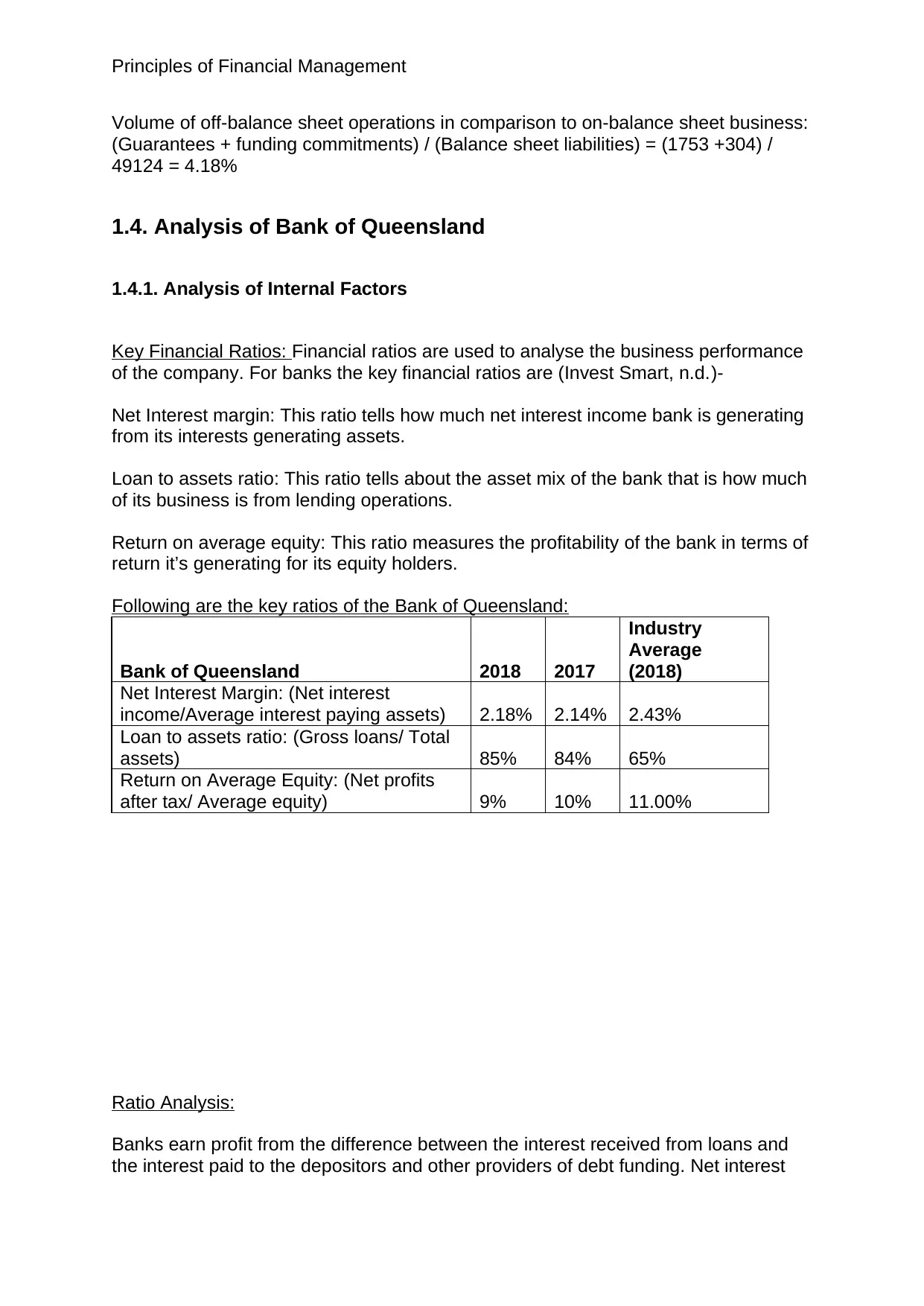
Principles of Financial Management
Volume of off-balance sheet operations in comparison to on-balance sheet business:
(Guarantees + funding commitments) / (Balance sheet liabilities) = (1753 +304) /
49124 = 4.18%
1.4. Analysis of Bank of Queensland
1.4.1. Analysis of Internal Factors
Key Financial Ratios: Financial ratios are used to analyse the business performance
of the company. For banks the key financial ratios are (Invest Smart, n.d.)-
Net Interest margin: This ratio tells how much net interest income bank is generating
from its interests generating assets.
Loan to assets ratio: This ratio tells about the asset mix of the bank that is how much
of its business is from lending operations.
Return on average equity: This ratio measures the profitability of the bank in terms of
return it’s generating for its equity holders.
Following are the key ratios of the Bank of Queensland:
Bank of Queensland 2018 2017
Industry
Average
(2018)
Net Interest Margin: (Net interest
income/Average interest paying assets) 2.18% 2.14% 2.43%
Loan to assets ratio: (Gross loans/ Total
assets) 85% 84% 65%
Return on Average Equity: (Net profits
after tax/ Average equity) 9% 10% 11.00%
Ratio Analysis:
Banks earn profit from the difference between the interest received from loans and
the interest paid to the depositors and other providers of debt funding. Net interest
Volume of off-balance sheet operations in comparison to on-balance sheet business:
(Guarantees + funding commitments) / (Balance sheet liabilities) = (1753 +304) /
49124 = 4.18%
1.4. Analysis of Bank of Queensland
1.4.1. Analysis of Internal Factors
Key Financial Ratios: Financial ratios are used to analyse the business performance
of the company. For banks the key financial ratios are (Invest Smart, n.d.)-
Net Interest margin: This ratio tells how much net interest income bank is generating
from its interests generating assets.
Loan to assets ratio: This ratio tells about the asset mix of the bank that is how much
of its business is from lending operations.
Return on average equity: This ratio measures the profitability of the bank in terms of
return it’s generating for its equity holders.
Following are the key ratios of the Bank of Queensland:
Bank of Queensland 2018 2017
Industry
Average
(2018)
Net Interest Margin: (Net interest
income/Average interest paying assets) 2.18% 2.14% 2.43%
Loan to assets ratio: (Gross loans/ Total
assets) 85% 84% 65%
Return on Average Equity: (Net profits
after tax/ Average equity) 9% 10% 11.00%
Ratio Analysis:
Banks earn profit from the difference between the interest received from loans and
the interest paid to the depositors and other providers of debt funding. Net interest
Paraphrase This Document
Need a fresh take? Get an instant paraphrase of this document with our AI Paraphraser
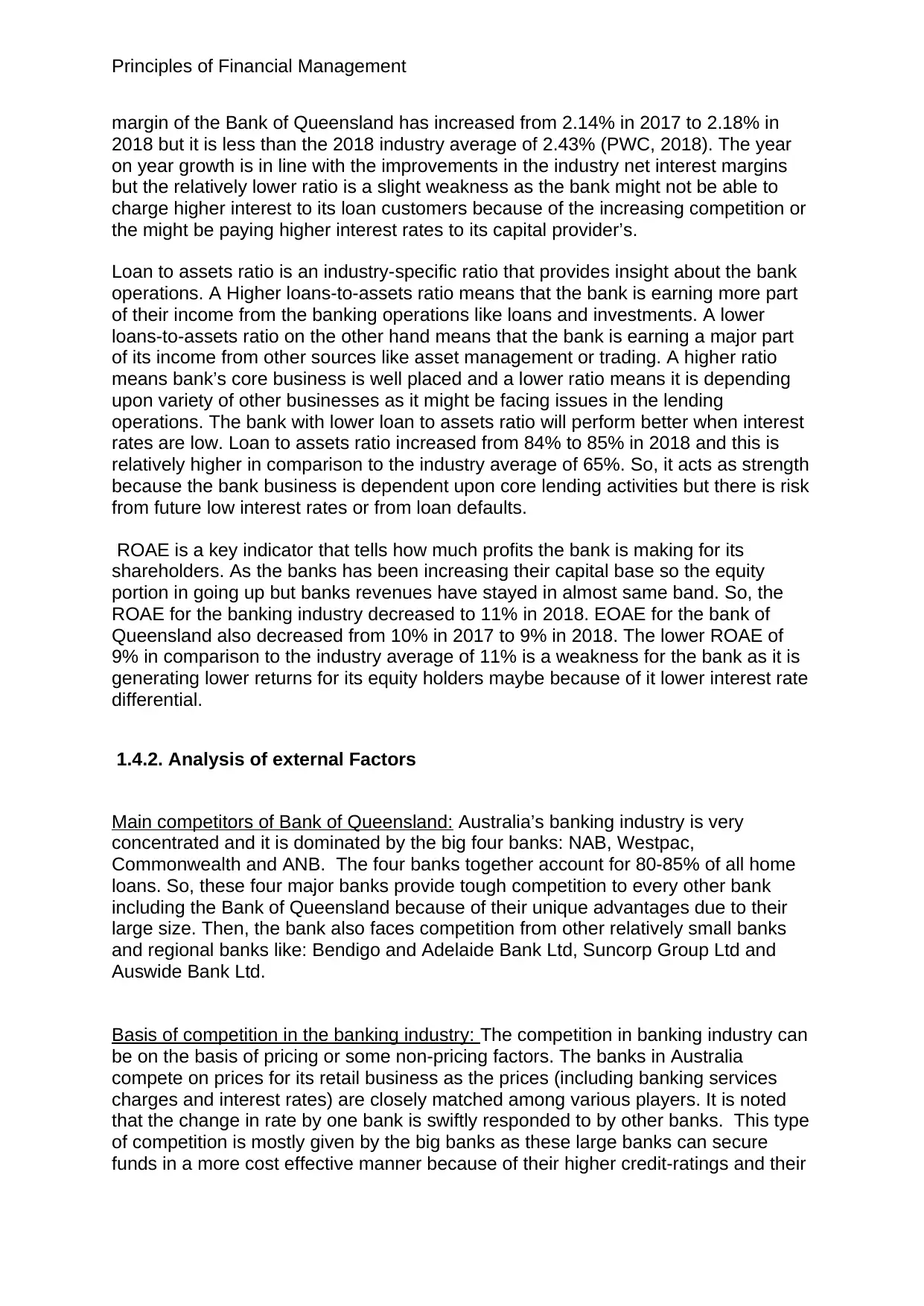
Principles of Financial Management
margin of the Bank of Queensland has increased from 2.14% in 2017 to 2.18% in
2018 but it is less than the 2018 industry average of 2.43% (PWC, 2018). The year
on year growth is in line with the improvements in the industry net interest margins
but the relatively lower ratio is a slight weakness as the bank might not be able to
charge higher interest to its loan customers because of the increasing competition or
the might be paying higher interest rates to its capital provider’s.
Loan to assets ratio is an industry-specific ratio that provides insight about the bank
operations. A Higher loans-to-assets ratio means that the bank is earning more part
of their income from the banking operations like loans and investments. A lower
loans-to-assets ratio on the other hand means that the bank is earning a major part
of its income from other sources like asset management or trading. A higher ratio
means bank’s core business is well placed and a lower ratio means it is depending
upon variety of other businesses as it might be facing issues in the lending
operations. The bank with lower loan to assets ratio will perform better when interest
rates are low. Loan to assets ratio increased from 84% to 85% in 2018 and this is
relatively higher in comparison to the industry average of 65%. So, it acts as strength
because the bank business is dependent upon core lending activities but there is risk
from future low interest rates or from loan defaults.
ROAE is a key indicator that tells how much profits the bank is making for its
shareholders. As the banks has been increasing their capital base so the equity
portion in going up but banks revenues have stayed in almost same band. So, the
ROAE for the banking industry decreased to 11% in 2018. EOAE for the bank of
Queensland also decreased from 10% in 2017 to 9% in 2018. The lower ROAE of
9% in comparison to the industry average of 11% is a weakness for the bank as it is
generating lower returns for its equity holders maybe because of it lower interest rate
differential.
1.4.2. Analysis of external Factors
Main competitors of Bank of Queensland: Australia’s banking industry is very
concentrated and it is dominated by the big four banks: NAB, Westpac,
Commonwealth and ANB. The four banks together account for 80-85% of all home
loans. So, these four major banks provide tough competition to every other bank
including the Bank of Queensland because of their unique advantages due to their
large size. Then, the bank also faces competition from other relatively small banks
and regional banks like: Bendigo and Adelaide Bank Ltd, Suncorp Group Ltd and
Auswide Bank Ltd.
Basis of competition in the banking industry: The competition in banking industry can
be on the basis of pricing or some non-pricing factors. The banks in Australia
compete on prices for its retail business as the prices (including banking services
charges and interest rates) are closely matched among various players. It is noted
that the change in rate by one bank is swiftly responded to by other banks. This type
of competition is mostly given by the big banks as these large banks can secure
funds in a more cost effective manner because of their higher credit-ratings and their
margin of the Bank of Queensland has increased from 2.14% in 2017 to 2.18% in
2018 but it is less than the 2018 industry average of 2.43% (PWC, 2018). The year
on year growth is in line with the improvements in the industry net interest margins
but the relatively lower ratio is a slight weakness as the bank might not be able to
charge higher interest to its loan customers because of the increasing competition or
the might be paying higher interest rates to its capital provider’s.
Loan to assets ratio is an industry-specific ratio that provides insight about the bank
operations. A Higher loans-to-assets ratio means that the bank is earning more part
of their income from the banking operations like loans and investments. A lower
loans-to-assets ratio on the other hand means that the bank is earning a major part
of its income from other sources like asset management or trading. A higher ratio
means bank’s core business is well placed and a lower ratio means it is depending
upon variety of other businesses as it might be facing issues in the lending
operations. The bank with lower loan to assets ratio will perform better when interest
rates are low. Loan to assets ratio increased from 84% to 85% in 2018 and this is
relatively higher in comparison to the industry average of 65%. So, it acts as strength
because the bank business is dependent upon core lending activities but there is risk
from future low interest rates or from loan defaults.
ROAE is a key indicator that tells how much profits the bank is making for its
shareholders. As the banks has been increasing their capital base so the equity
portion in going up but banks revenues have stayed in almost same band. So, the
ROAE for the banking industry decreased to 11% in 2018. EOAE for the bank of
Queensland also decreased from 10% in 2017 to 9% in 2018. The lower ROAE of
9% in comparison to the industry average of 11% is a weakness for the bank as it is
generating lower returns for its equity holders maybe because of it lower interest rate
differential.
1.4.2. Analysis of external Factors
Main competitors of Bank of Queensland: Australia’s banking industry is very
concentrated and it is dominated by the big four banks: NAB, Westpac,
Commonwealth and ANB. The four banks together account for 80-85% of all home
loans. So, these four major banks provide tough competition to every other bank
including the Bank of Queensland because of their unique advantages due to their
large size. Then, the bank also faces competition from other relatively small banks
and regional banks like: Bendigo and Adelaide Bank Ltd, Suncorp Group Ltd and
Auswide Bank Ltd.
Basis of competition in the banking industry: The competition in banking industry can
be on the basis of pricing or some non-pricing factors. The banks in Australia
compete on prices for its retail business as the prices (including banking services
charges and interest rates) are closely matched among various players. It is noted
that the change in rate by one bank is swiftly responded to by other banks. This type
of competition is mostly given by the big banks as these large banks can secure
funds in a more cost effective manner because of their higher credit-ratings and their

Principles of Financial Management
systematically important position. The non-pricing competition on the basis of quality
and access to services and product features is given by the relatively small regional
players as these small banks can focus on particular product category and focus
more on the customer service (Deloitte, 2014).
Impact of the competition: The competition can create both threats and opportunities.
The price competition from the big four banks can put negative pressure on the
profitability of Bank of Queensland as if the bank is unable to get funds in a cost
effective manner because of its relatively smaller size then it will be not able to
provide competitive rates to its customers and there will threat to its existence. But
there are also new opportunities as the non-pricing competition can encourage the
bank to invest more in technology and product innovation to stand out from the other
regional banks.
1.5. Financial Market Analysis
1.5.1. Interaction between different financial players in the banking industry
BOQ acts as a financial intermediary and allows the investors/lenders to provide
funds to the borrowers in an efficient manner. Investors can put their money in the
bank via deposit account or term deposits to earn returns. The borrowers can apply
for loans by providing all the required details and they will need to pay interest rate
on this loan amount. Banks form the backbone of the financial market of the nation
and their failure can lead to systemic risk. So, regulators keep a close watch on
banks in order to monitor their business activities to prevent future frauds and
failures. This is done by subjecting banks to certain requirements, restrictions and
guidelines.
Relationship between the various financial players appears to be mutually beneficial.
The lenders are able to lend their money at competitive rates without doing any
research about the borrowers and they even need not to worry about the risk of
default as bank guarantees the deposit money. Similarly, borrowers need not to
waste resources to find individual investors but they can borrow directly from the
banks at low rates because of high degree of competition in banking industry. Banks
earn from this interest rate differential. The increased competition may have
decreased this interest rate margin but the growing economic activities have helped
financial intermediaries via higher transactions and volumes. This has also helped
the small investors and borrowers as they now have access to the financial markets
due to the financial inclusion programs of the banks.
1.5.2. Government/Regulators Intervention
The banking industry is responsible for the economic growth of the nation and failure
of banks can have devastating effect on the country. So, the governments need to
regulate this industry. Also, the inquiry into banking and related financial firms has
made public various misconducts by these firms. These malpractices have affected
the general public in an adverse manner. The poor conduct by the banks included
various activities like fraudulent documentation, administration errors, breaches of
systematically important position. The non-pricing competition on the basis of quality
and access to services and product features is given by the relatively small regional
players as these small banks can focus on particular product category and focus
more on the customer service (Deloitte, 2014).
Impact of the competition: The competition can create both threats and opportunities.
The price competition from the big four banks can put negative pressure on the
profitability of Bank of Queensland as if the bank is unable to get funds in a cost
effective manner because of its relatively smaller size then it will be not able to
provide competitive rates to its customers and there will threat to its existence. But
there are also new opportunities as the non-pricing competition can encourage the
bank to invest more in technology and product innovation to stand out from the other
regional banks.
1.5. Financial Market Analysis
1.5.1. Interaction between different financial players in the banking industry
BOQ acts as a financial intermediary and allows the investors/lenders to provide
funds to the borrowers in an efficient manner. Investors can put their money in the
bank via deposit account or term deposits to earn returns. The borrowers can apply
for loans by providing all the required details and they will need to pay interest rate
on this loan amount. Banks form the backbone of the financial market of the nation
and their failure can lead to systemic risk. So, regulators keep a close watch on
banks in order to monitor their business activities to prevent future frauds and
failures. This is done by subjecting banks to certain requirements, restrictions and
guidelines.
Relationship between the various financial players appears to be mutually beneficial.
The lenders are able to lend their money at competitive rates without doing any
research about the borrowers and they even need not to worry about the risk of
default as bank guarantees the deposit money. Similarly, borrowers need not to
waste resources to find individual investors but they can borrow directly from the
banks at low rates because of high degree of competition in banking industry. Banks
earn from this interest rate differential. The increased competition may have
decreased this interest rate margin but the growing economic activities have helped
financial intermediaries via higher transactions and volumes. This has also helped
the small investors and borrowers as they now have access to the financial markets
due to the financial inclusion programs of the banks.
1.5.2. Government/Regulators Intervention
The banking industry is responsible for the economic growth of the nation and failure
of banks can have devastating effect on the country. So, the governments need to
regulate this industry. Also, the inquiry into banking and related financial firms has
made public various misconducts by these firms. These malpractices have affected
the general public in an adverse manner. The poor conduct by the banks included
various activities like fraudulent documentation, administration errors, breaches of
⊘ This is a preview!⊘
Do you want full access?
Subscribe today to unlock all pages.

Trusted by 1+ million students worldwide
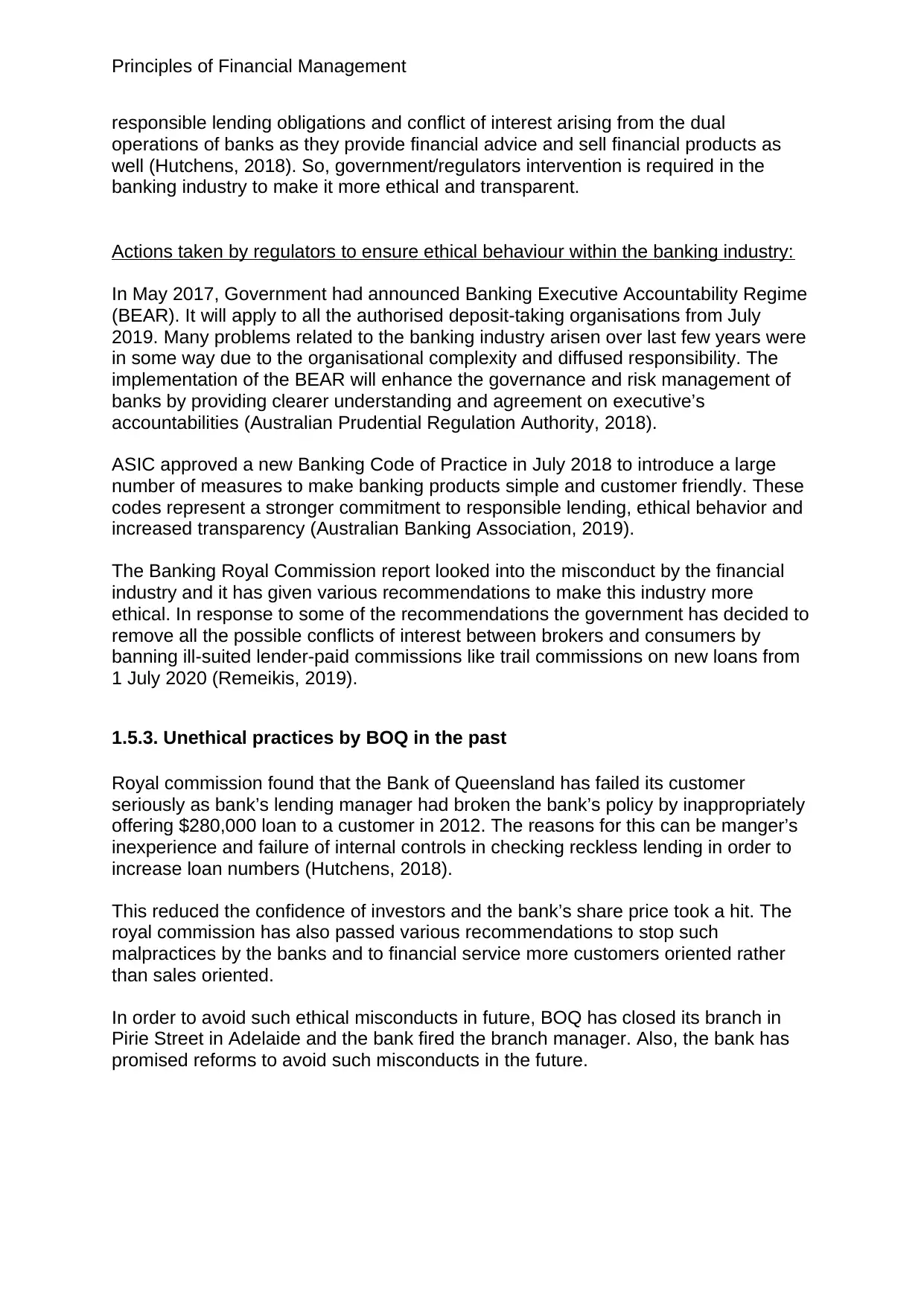
Principles of Financial Management
responsible lending obligations and conflict of interest arising from the dual
operations of banks as they provide financial advice and sell financial products as
well (Hutchens, 2018). So, government/regulators intervention is required in the
banking industry to make it more ethical and transparent.
Actions taken by regulators to ensure ethical behaviour within the banking industry:
In May 2017, Government had announced Banking Executive Accountability Regime
(BEAR). It will apply to all the authorised deposit-taking organisations from July
2019. Many problems related to the banking industry arisen over last few years were
in some way due to the organisational complexity and diffused responsibility. The
implementation of the BEAR will enhance the governance and risk management of
banks by providing clearer understanding and agreement on executive’s
accountabilities (Australian Prudential Regulation Authority, 2018).
ASIC approved a new Banking Code of Practice in July 2018 to introduce a large
number of measures to make banking products simple and customer friendly. These
codes represent a stronger commitment to responsible lending, ethical behavior and
increased transparency (Australian Banking Association, 2019).
The Banking Royal Commission report looked into the misconduct by the financial
industry and it has given various recommendations to make this industry more
ethical. In response to some of the recommendations the government has decided to
remove all the possible conflicts of interest between brokers and consumers by
banning ill-suited lender-paid commissions like trail commissions on new loans from
1 July 2020 (Remeikis, 2019).
1.5.3. Unethical practices by BOQ in the past
Royal commission found that the Bank of Queensland has failed its customer
seriously as bank’s lending manager had broken the bank’s policy by inappropriately
offering $280,000 loan to a customer in 2012. The reasons for this can be manger’s
inexperience and failure of internal controls in checking reckless lending in order to
increase loan numbers (Hutchens, 2018).
This reduced the confidence of investors and the bank’s share price took a hit. The
royal commission has also passed various recommendations to stop such
malpractices by the banks and to financial service more customers oriented rather
than sales oriented.
In order to avoid such ethical misconducts in future, BOQ has closed its branch in
Pirie Street in Adelaide and the bank fired the branch manager. Also, the bank has
promised reforms to avoid such misconducts in the future.
responsible lending obligations and conflict of interest arising from the dual
operations of banks as they provide financial advice and sell financial products as
well (Hutchens, 2018). So, government/regulators intervention is required in the
banking industry to make it more ethical and transparent.
Actions taken by regulators to ensure ethical behaviour within the banking industry:
In May 2017, Government had announced Banking Executive Accountability Regime
(BEAR). It will apply to all the authorised deposit-taking organisations from July
2019. Many problems related to the banking industry arisen over last few years were
in some way due to the organisational complexity and diffused responsibility. The
implementation of the BEAR will enhance the governance and risk management of
banks by providing clearer understanding and agreement on executive’s
accountabilities (Australian Prudential Regulation Authority, 2018).
ASIC approved a new Banking Code of Practice in July 2018 to introduce a large
number of measures to make banking products simple and customer friendly. These
codes represent a stronger commitment to responsible lending, ethical behavior and
increased transparency (Australian Banking Association, 2019).
The Banking Royal Commission report looked into the misconduct by the financial
industry and it has given various recommendations to make this industry more
ethical. In response to some of the recommendations the government has decided to
remove all the possible conflicts of interest between brokers and consumers by
banning ill-suited lender-paid commissions like trail commissions on new loans from
1 July 2020 (Remeikis, 2019).
1.5.3. Unethical practices by BOQ in the past
Royal commission found that the Bank of Queensland has failed its customer
seriously as bank’s lending manager had broken the bank’s policy by inappropriately
offering $280,000 loan to a customer in 2012. The reasons for this can be manger’s
inexperience and failure of internal controls in checking reckless lending in order to
increase loan numbers (Hutchens, 2018).
This reduced the confidence of investors and the bank’s share price took a hit. The
royal commission has also passed various recommendations to stop such
malpractices by the banks and to financial service more customers oriented rather
than sales oriented.
In order to avoid such ethical misconducts in future, BOQ has closed its branch in
Pirie Street in Adelaide and the bank fired the branch manager. Also, the bank has
promised reforms to avoid such misconducts in the future.
Paraphrase This Document
Need a fresh take? Get an instant paraphrase of this document with our AI Paraphraser
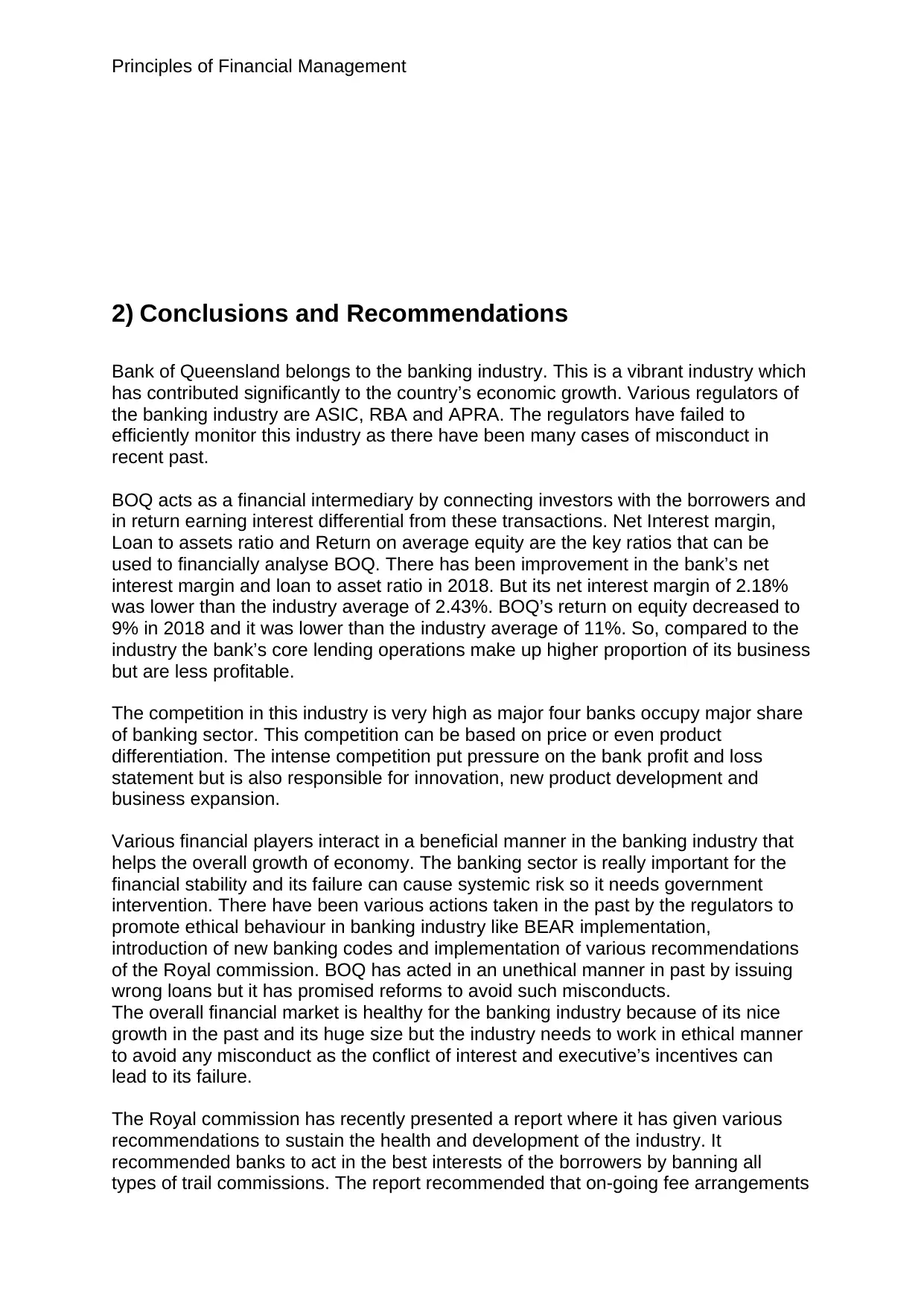
Principles of Financial Management
2) Conclusions and Recommendations
Bank of Queensland belongs to the banking industry. This is a vibrant industry which
has contributed significantly to the country’s economic growth. Various regulators of
the banking industry are ASIC, RBA and APRA. The regulators have failed to
efficiently monitor this industry as there have been many cases of misconduct in
recent past.
BOQ acts as a financial intermediary by connecting investors with the borrowers and
in return earning interest differential from these transactions. Net Interest margin,
Loan to assets ratio and Return on average equity are the key ratios that can be
used to financially analyse BOQ. There has been improvement in the bank’s net
interest margin and loan to asset ratio in 2018. But its net interest margin of 2.18%
was lower than the industry average of 2.43%. BOQ’s return on equity decreased to
9% in 2018 and it was lower than the industry average of 11%. So, compared to the
industry the bank’s core lending operations make up higher proportion of its business
but are less profitable.
The competition in this industry is very high as major four banks occupy major share
of banking sector. This competition can be based on price or even product
differentiation. The intense competition put pressure on the bank profit and loss
statement but is also responsible for innovation, new product development and
business expansion.
Various financial players interact in a beneficial manner in the banking industry that
helps the overall growth of economy. The banking sector is really important for the
financial stability and its failure can cause systemic risk so it needs government
intervention. There have been various actions taken in the past by the regulators to
promote ethical behaviour in banking industry like BEAR implementation,
introduction of new banking codes and implementation of various recommendations
of the Royal commission. BOQ has acted in an unethical manner in past by issuing
wrong loans but it has promised reforms to avoid such misconducts.
The overall financial market is healthy for the banking industry because of its nice
growth in the past and its huge size but the industry needs to work in ethical manner
to avoid any misconduct as the conflict of interest and executive’s incentives can
lead to its failure.
The Royal commission has recently presented a report where it has given various
recommendations to sustain the health and development of the industry. It
recommended banks to act in the best interests of the borrowers by banning all
types of trail commissions. The report recommended that on-going fee arrangements
2) Conclusions and Recommendations
Bank of Queensland belongs to the banking industry. This is a vibrant industry which
has contributed significantly to the country’s economic growth. Various regulators of
the banking industry are ASIC, RBA and APRA. The regulators have failed to
efficiently monitor this industry as there have been many cases of misconduct in
recent past.
BOQ acts as a financial intermediary by connecting investors with the borrowers and
in return earning interest differential from these transactions. Net Interest margin,
Loan to assets ratio and Return on average equity are the key ratios that can be
used to financially analyse BOQ. There has been improvement in the bank’s net
interest margin and loan to asset ratio in 2018. But its net interest margin of 2.18%
was lower than the industry average of 2.43%. BOQ’s return on equity decreased to
9% in 2018 and it was lower than the industry average of 11%. So, compared to the
industry the bank’s core lending operations make up higher proportion of its business
but are less profitable.
The competition in this industry is very high as major four banks occupy major share
of banking sector. This competition can be based on price or even product
differentiation. The intense competition put pressure on the bank profit and loss
statement but is also responsible for innovation, new product development and
business expansion.
Various financial players interact in a beneficial manner in the banking industry that
helps the overall growth of economy. The banking sector is really important for the
financial stability and its failure can cause systemic risk so it needs government
intervention. There have been various actions taken in the past by the regulators to
promote ethical behaviour in banking industry like BEAR implementation,
introduction of new banking codes and implementation of various recommendations
of the Royal commission. BOQ has acted in an unethical manner in past by issuing
wrong loans but it has promised reforms to avoid such misconducts.
The overall financial market is healthy for the banking industry because of its nice
growth in the past and its huge size but the industry needs to work in ethical manner
to avoid any misconduct as the conflict of interest and executive’s incentives can
lead to its failure.
The Royal commission has recently presented a report where it has given various
recommendations to sustain the health and development of the industry. It
recommended banks to act in the best interests of the borrowers by banning all
types of trail commissions. The report recommended that on-going fee arrangements
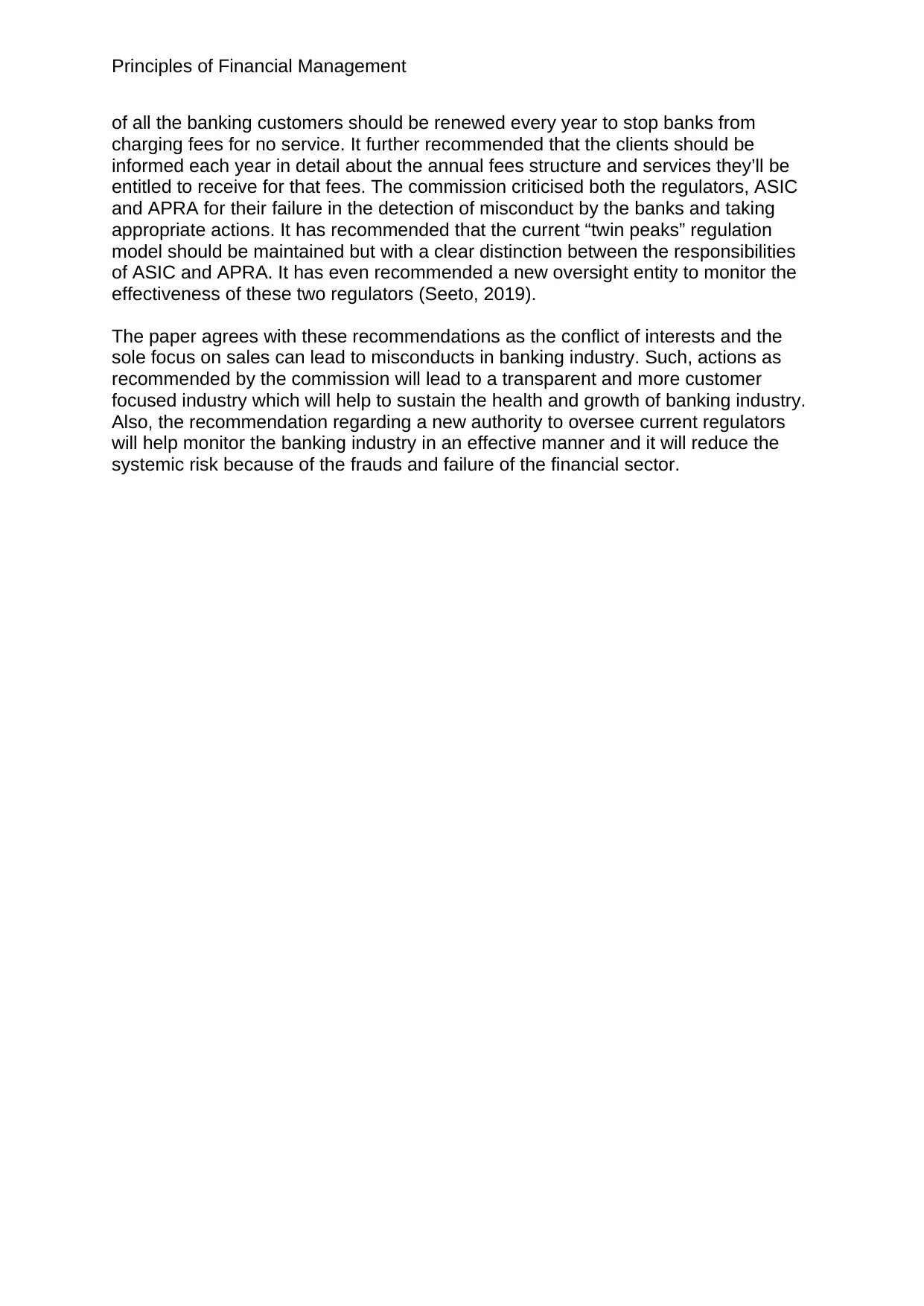
Principles of Financial Management
of all the banking customers should be renewed every year to stop banks from
charging fees for no service. It further recommended that the clients should be
informed each year in detail about the annual fees structure and services they’ll be
entitled to receive for that fees. The commission criticised both the regulators, ASIC
and APRA for their failure in the detection of misconduct by the banks and taking
appropriate actions. It has recommended that the current “twin peaks” regulation
model should be maintained but with a clear distinction between the responsibilities
of ASIC and APRA. It has even recommended a new oversight entity to monitor the
effectiveness of these two regulators (Seeto, 2019).
The paper agrees with these recommendations as the conflict of interests and the
sole focus on sales can lead to misconducts in banking industry. Such, actions as
recommended by the commission will lead to a transparent and more customer
focused industry which will help to sustain the health and growth of banking industry.
Also, the recommendation regarding a new authority to oversee current regulators
will help monitor the banking industry in an effective manner and it will reduce the
systemic risk because of the frauds and failure of the financial sector.
of all the banking customers should be renewed every year to stop banks from
charging fees for no service. It further recommended that the clients should be
informed each year in detail about the annual fees structure and services they’ll be
entitled to receive for that fees. The commission criticised both the regulators, ASIC
and APRA for their failure in the detection of misconduct by the banks and taking
appropriate actions. It has recommended that the current “twin peaks” regulation
model should be maintained but with a clear distinction between the responsibilities
of ASIC and APRA. It has even recommended a new oversight entity to monitor the
effectiveness of these two regulators (Seeto, 2019).
The paper agrees with these recommendations as the conflict of interests and the
sole focus on sales can lead to misconducts in banking industry. Such, actions as
recommended by the commission will lead to a transparent and more customer
focused industry which will help to sustain the health and growth of banking industry.
Also, the recommendation regarding a new authority to oversee current regulators
will help monitor the banking industry in an effective manner and it will reduce the
systemic risk because of the frauds and failure of the financial sector.
⊘ This is a preview!⊘
Do you want full access?
Subscribe today to unlock all pages.

Trusted by 1+ million students worldwide
1 out of 18
Related Documents
Your All-in-One AI-Powered Toolkit for Academic Success.
+13062052269
info@desklib.com
Available 24*7 on WhatsApp / Email
![[object Object]](/_next/static/media/star-bottom.7253800d.svg)
Unlock your academic potential
Copyright © 2020–2025 A2Z Services. All Rights Reserved. Developed and managed by ZUCOL.




